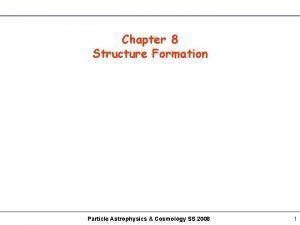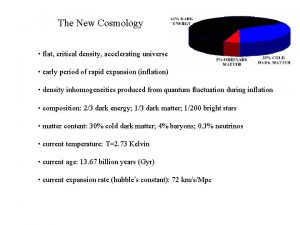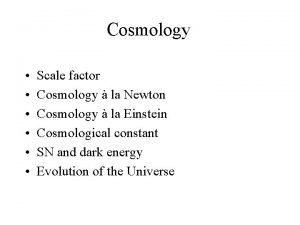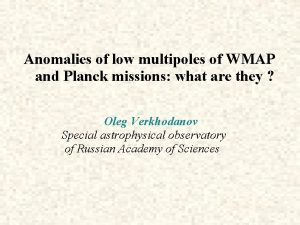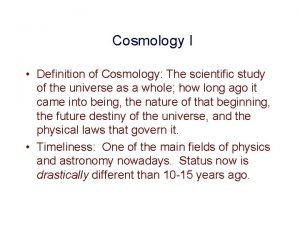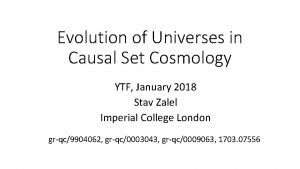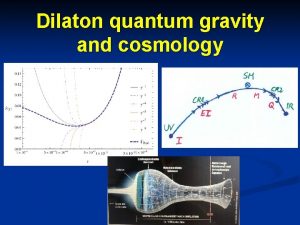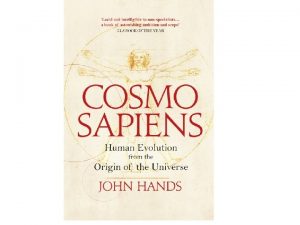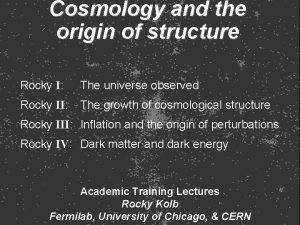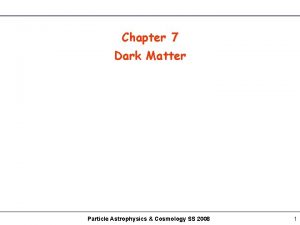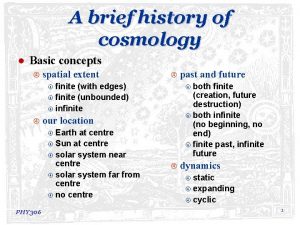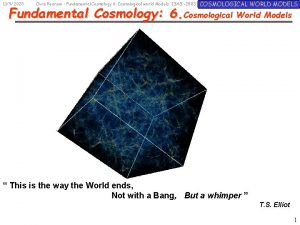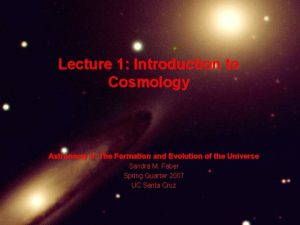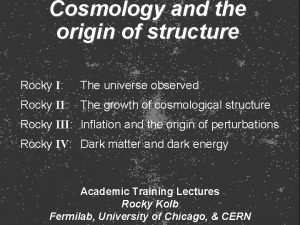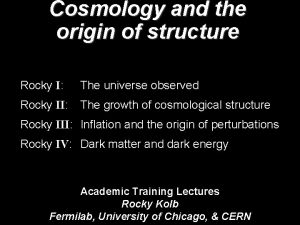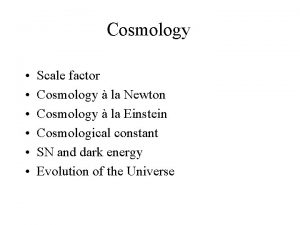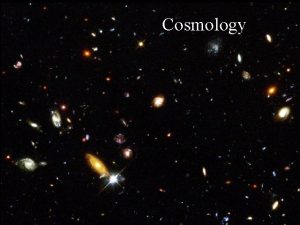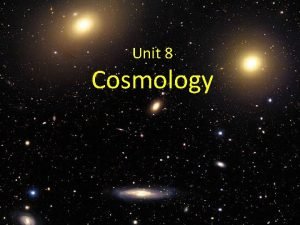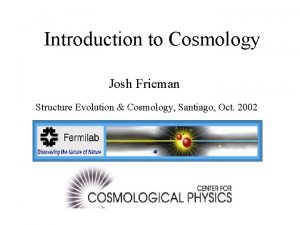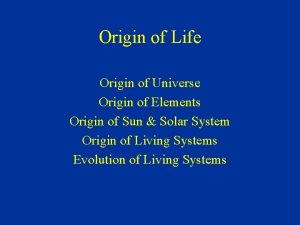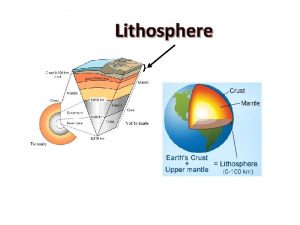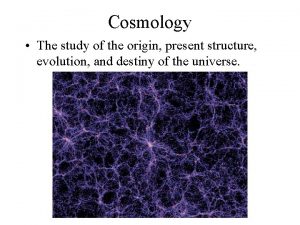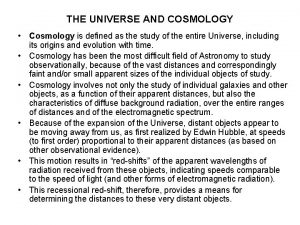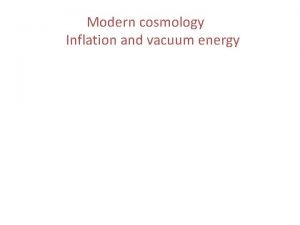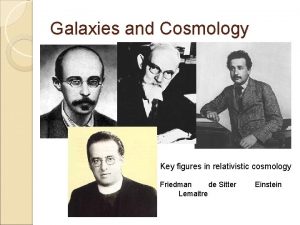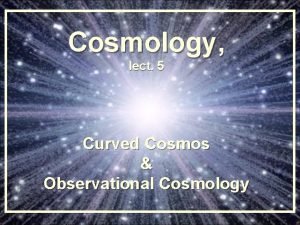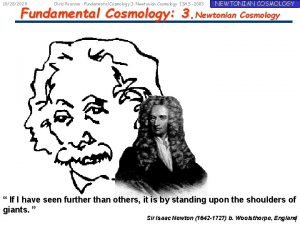Cosmology and the origin of structure Rocky I

































- Slides: 33

Cosmology and the origin of structure Rocky I: The universe observed Rocky II: The growth of cosmological structure Rocky III: Inflation and the origin of perturbations Rocky IV: Dark matter and dark energy Academic Training Lectures Rocky Kolb Fermilab, University of Chicago, & CERN

Rocky II: Growth of structure • Linear regime: quantative analysis Jeans analysis Sub-Hubble-radius perturbations (Newtonian) Super-Hubble-radius perturbations (GR) Harrison-Zel’dovich spectrum Dissipative processes The transfer function Linear evolution • Non-linear regime: word calculus Comparison to observations A few clouds on the horizon

Growth of small perturbations Today (12 Gyr AB) • radiation and matter decoupled • • Before recombination (300 kyr AB) • radiation and matter decoupled • •

Seeds of structure tim e

Oxford English Dictionary

Power spectrum • Assume there is an average density • Expand density contrast in Fourier modes • Autocorrelation function defines power spectrum

Jeans analysis in a non-expanding fluid: matter density pressure velocity field gravitational potential Perturb about solution*

Jeans analysis solutions of the form real: perturbations oscillate as sound waves imaginary: exponentially growing (or decaying) modes Jeans wavenumber Jeans mass gravitational pressure vs. thermal pressure

Sub-Hubble-radius (RH=H-1) Jeans analysis in an expanding fluid: scale factor a(t) describes expansion, unperturbed solution: * • Solution is some sort of Bessel function: growth or oscillation depends on Jeans criterion • In matter-dominated era • For wavenumbers less than Jeans

Super-Hubble-radius (RH=H-1) • complete analysis not for the faint of heart • interested in “scalar” perturbations • fourth-order differential equation • only two solutions “physical” • other two solutions are “gauge modes” which can be removed by a coordinate transformation on the unperturbed metric

Bardeen 1980 Reference spacetime: flat FRW


Bardeen 1980 Reference spacetime: flat FRW Perturbed spacetime (10 degrees of freedom):

reference flat spatial hypersurfaces actual curved spatial hypersurfaces

scalar, vector, tensor decomposition 1 2+1+2+1 10 evolution of scalar, vector, and tensor perturbations decoupled

Vector Perturbations: • are not sourced by stress tensor • decay rapidly in expansion Tensor Perturbations: • perturbations of transverse, traceless component of the metric: gravitational waves • do not couple to stress tensor Scalar Perturbations • couple to stress tensor • density perturbations!

Super-Hubble-radius in synchronous gauge and uniform Hubble flow gauge • in matter-dominated era • in radiation-dominated era

Harrison-Zel’dovich in radiation-dominated era in matter-dominated era log d ~ ) k n ) (k k P P( super Hubble-radius ~ n k k. H log k sub Hubble-radius k. H log k

Harrison-Zel’dovich log d 1 k ~ ) “flat” spectrum D 2(k)=k 3 P(k)~const k P( in radiation-dominated era k. H log k log d k. H log k

Harrison-Zel’dovich log d “flat” spectrum D 2(k)=k 3 P(k)~const 1 k ~ ) k P( log k k. H • in radiation-dominated era no growth sub-Hubble radius growth as t super-Hubble radius log P(k) k k) P( P( )~ 1 k -3 ~k k. H • in matter-dominated era power spectrum grows as t 2/3 on all scales log k

Power spectrum for CDM log P(k) k) P( P )~ k ( 1 k -3 ~k matter-radiation equality log k 1 k -3 k

Dissipative processes 1. Collisionless phase mixing – free streaming If dark matter is relativistic or semi-relativistic particles can stream out of overdense regions and smooth out inhomogeneities. The faster the particle the longer its freestreaming length. Quintessential example: e. V-range neutrinos

The evolved spectrum

Dissipative processes 1. Collisionless phase mixing – free streaming If dark matter is relativistic or semi-relativistic particles can stream out of overdense regions and smooth out inhomogeneities. The faster the particle the longer its freestreaming length. Quintessential example: e. V-range neutrinos 2. Collisional damping – Silk damping As baryons decouple from photons, the photonmean-free path becomes large. As photons escape from dense regions, they can drag baryons along, erasing baryon perturbations on small scales. Baryon-photon fluid suffers damped oscillations.

The evolved spectrum

Linear evolution today z=1000

Linear evolution y a d o 0 t 1 z= 00 1 = 0 z 0 0 1 z=

Life ain’t linear! • Many scales become nonlinear at about the same time • Mergers from many smaller objects while larger scales form • N-body simulations for dissipation-less dark matter • Hydro needed for baryons • Power spectrum well fit if G = Wh ~ 0. 2 • There is more to life than the power spectrum Alex Szalay

Largescale structure fits well

Small-scale structure-cusps Moore et al.

Small-scale structure-satellites Moore et al.

Rocky II: Growth of structure • Linear regime: quantative analysis Jeans analysis Sub-Hubble-radius perturbations (Newtonian) Super-Hubble-radius perturbations (GR) Harrison-Zel’dovich spectrum Dissipative processes The transfer function Linear evolution • Non-linear regime: word calculus Comparison to observations A few clouds on the horizon

Cosmology and the origin of structure Rocky I: The observed universe Rocky II: The growth of cosmological structure Rocky III: Inflation and the origin of perturbations Rocky IV: Dark matter and dark energy Academic Training Lectures Rocky Kolb Fermilab, University of Chicago, & CERN
 Cosmology
Cosmology Critical density
Critical density Scale factor cosmology
Scale factor cosmology Multipole expansion
Multipole expansion Definition of cosmology
Definition of cosmology Cosmology
Cosmology Dilaton
Dilaton Concordance model of cosmology
Concordance model of cosmology Cosmology
Cosmology Cosmology
Cosmology Newton cosmology
Newton cosmology Cosmology
Cosmology Intro to cosmology
Intro to cosmology Jainism
Jainism Which colonial region contained rocky soil and cold climate
Which colonial region contained rocky soil and cold climate Rocky bay family services
Rocky bay family services A section of the nile river with rapids and rocky terrain
A section of the nile river with rapids and rocky terrain Hình ảnh bộ gõ cơ thể búng tay
Hình ảnh bộ gõ cơ thể búng tay Lp html
Lp html Bổ thể
Bổ thể Tỉ lệ cơ thể trẻ em
Tỉ lệ cơ thể trẻ em Gấu đi như thế nào
Gấu đi như thế nào Chụp tư thế worms-breton
Chụp tư thế worms-breton Chúa yêu trần thế alleluia
Chúa yêu trần thế alleluia Kể tên các môn thể thao
Kể tên các môn thể thao Thế nào là hệ số cao nhất
Thế nào là hệ số cao nhất Các châu lục và đại dương trên thế giới
Các châu lục và đại dương trên thế giới Công của trọng lực
Công của trọng lực Trời xanh đây là của chúng ta thể thơ
Trời xanh đây là của chúng ta thể thơ Cách giải mật thư tọa độ
Cách giải mật thư tọa độ Phép trừ bù
Phép trừ bù Phản ứng thế ankan
Phản ứng thế ankan Các châu lục và đại dương trên thế giới
Các châu lục và đại dương trên thế giới Thể thơ truyền thống
Thể thơ truyền thống
